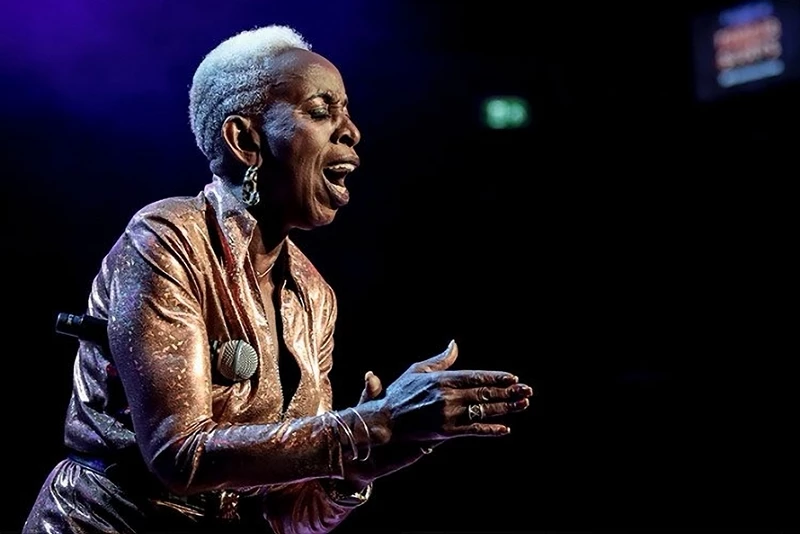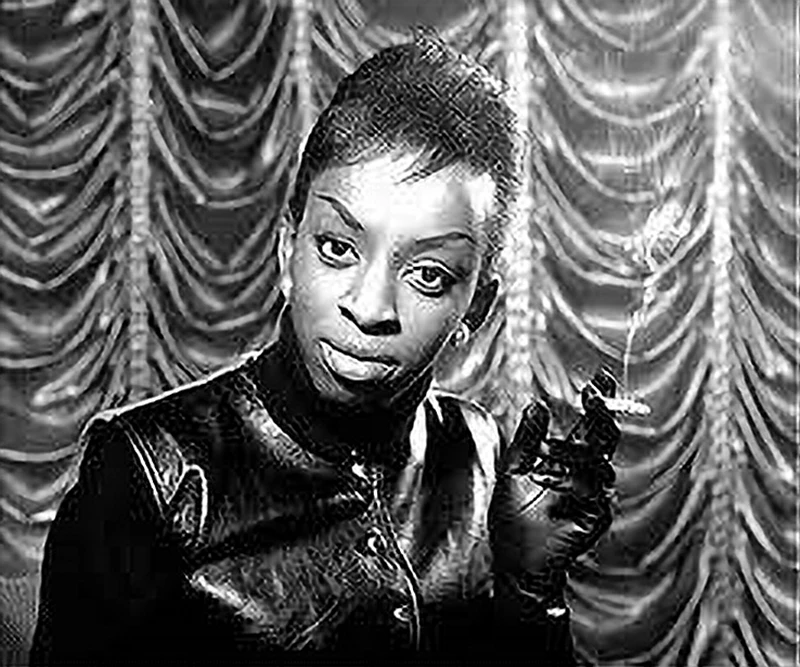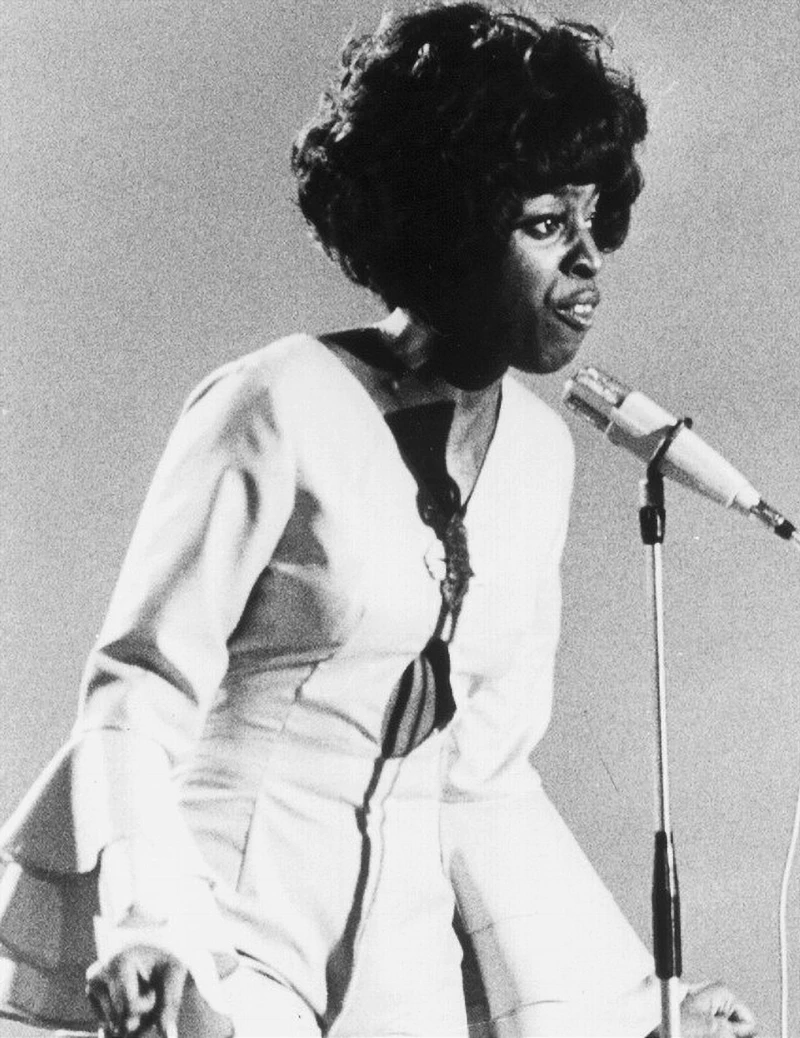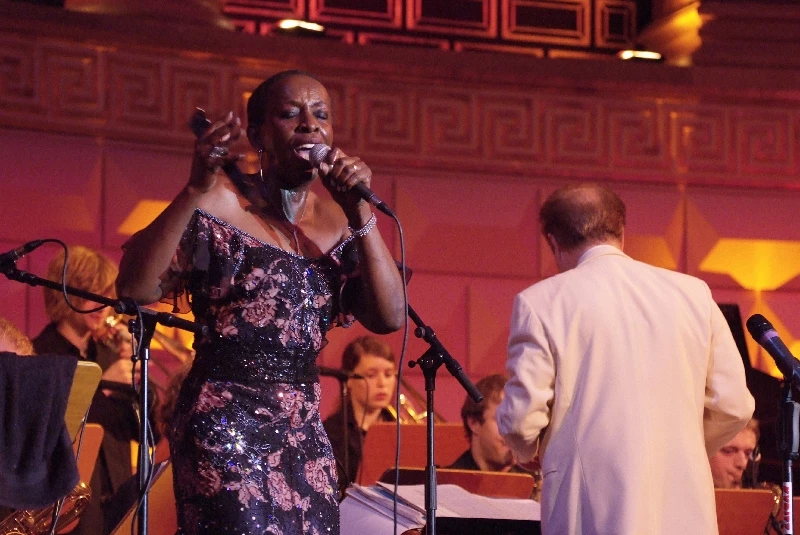Pennyblackmusic went to meet Madeline Bell to discuss her wonderful life and career. Madeline got her start in music by singing in church and school choirs in Newark, New Jersey, before moving to the UK in the 1960s, where she found regular work as an in-demand session singer. She worked with many major artists of the era, including Serge Gainsbourg, The Rolling Stones and John Lennon. She was also a member of the group Blue Mink, who had a hit with 'Melting Pot' in 1969. Madeline also had an incredible solo career as an artist in her own right and released several era defining records. Madeline discusses her memories of her friendship with Dusty Springfield, the work they did together and how Dusty was responsible for popularising Motown music in the UK. PB: I wanted to say, Madeline, I've been meaning to run into you for around ten years or so. And I'm so glad that it’s finally happened. I've not been in the same room as you while you're singing until today, and hearing you singing live, in person, is just incredible. What a privilege to sit in on the soundcheck. How do you keep your voice in such incredible shape? MB: I'm just blessed. I really could not tell you. I mean, I have a bad habit. I smoke. And I don't do vocal exercises because the last time I did a vocal exercise, I lost my voice and that let me know I was doing it wrong. I just go, *clears throat*; if I can do that, I'm okay, we're in for the show. I don't know what it is. I don't know about this smoking thing. I mean, maybe it's a myth. PB: So taking you right back, Madeline, you sang in the gospel churches. MB: I started off in school. I was in every choir in school. And then, I was in every choir in church: the children's choir and ladies’ choir, and then all the choirs. I was always part of them all, because I always wanted to sing. So, I started off in church but also in school. PB: How did you break through into working with people like Serge Gainsbourg? MB: Now, that, I don't know. I don't even remember the session with Serge Gainsbourg because it probably would have been in Paris. And we worked so much: myself, Sue and Sunny. The three of us used to do a lot in Paris. We'd fly in in the morning, do the session and fly out. Sometimes we didn't even know who the artist was. And I really do not remember the Serge Gainsbourg sessions. I got more wrapped up in Johnny Hallyday. PB: Johnny was a huge star, wasn’t he? MB: He was and my affection was for Johnny. I did sessions for loads of people but we didn't always know who they were. PB: Because the artists weren't always there at the time you were recording? MB: That was the case as well. And even when we did Donna Summer, she wasn't there the whole time. She came in for a photo session and they filmed her. But she wasn't there for the whole session. I mean, we used to get booked on sessions in the UK, as well, and we didn't know who the artist was until we got there. Like Joe Cocker. We didn't know him at all because he was new to everybody. Same thing with The Stones. When we got booked, we didn't know we were doing a session for The Stones until we got to Olympic Studios. And it was like, wow! PB: Was that because it was kept on the lowdown? MB: Yeah, they had to keep a low profile because they were such big stars. The session I did for Billy Preston was produced by George Harrison and we couldn't start until midnight because George couldn't go out at the time. We had Eric Clapton on guitar, Klaus Voormann on bass, though they keep saying it was Keith Richards, and it wasn't Keith Richards. I know that because I was there! It was Klaus Voormann, a German bass player and he's actually on the George Harrison tribute that was at the Albert Hall. We would start at twelve midnight and finish at about four or five o 'clock in the morning so that George could get home because he would be attacked in the street if he was seen in those days. PB: While we're talking about George you worked with John Lennon, didn't you? MB: Yes on ‘Power to the People.’ PB: What a great track to be a part of! MB: The first thing you hear is stomping, marching feet and that’s us! When we started recording, we sang “Power to the people!” and then John came down and asked if we could make it a bit more powerful, more aggressive. He said, “Can you stomp your feet like you’re marching?” So, we did. Then he came down again and said, “Can you be even more aggressive and can you do it with your fists up in the air?” That's how fifteen of us sang it. We were in the studio about three hours before they even started because John's manager, Allen Klein, was having a big row with the producer, Phil Spector, and we could see it all going on upstairs. John told us to chill out and said that the canteen was open and we could have anything we wanted. He said when we're ready we'll let you know but we didn't care because it was John Lennon. PB: And was that the only time you worked with Phil Spector? MB: I think so. PB: Another musical genius, but a very troubled man by all accounts. MB: Yeah, we weren't involved in all of that, thankfully. We could just see the pointing in the control box. You could see the aggression that was going on up in the studio. PB: I read that you were so busy in those days that your sessions would be back-to-back with barely enough time to catch the bus to get to the next studio. Did you get the jobs by word of mouth or was it through an agent at the time? MB: There were agents as well as people that would call you directly, agents like Charlie Katz and David Katz. They would have wanted to book you for sessions but then people eventually started calling us but not all of us had telephones in those days. We had to make ourselves available to the fixers as they called them. The fixers usually were string players. : PB: Do you think it was more common, as the years went by, that the main artist wouldn't be there for the sessions? MB: Well. in the ‘60s the artist was usually there because in those days we would record everything at one time. The live vocals would be in one little cubby hole, the backing singers would be in another little cubby hole, then you'd have the drum kit, which would be blocked away and the full orchestra with strings and everything was done at the same time. Nowadays, you don't even have to be in the same country, but then it was all done together and in three hours we would do four tracks sometimes. Lesley Duncan and I didn’t read music. We had Kay Garner from Hull who was the only reader. So, we would get in the studio, and ,as soon as we got there, Kay would go straight to the piano and pick out our keys and everything. We learned how to have a quick ear because you had to learn quickly. You couldn’t spend too much time learning your part. PB: Well, time is money, isn't it? I guess you would have to learn very quickly, wouldn't you? MB: We did, and we always got there early. That's why I'm still doing that. I'm always early because in the early days, time really was money and we learned. In those days, if the studio sessions started at ten, you always made sure you were there by quarter to ten, so you could sit down and calm down because it took so long to get there. None of us had a car at that time. I didn't drive until 1970, so this was the early days. The good thing is that I now know how to use London Transport. I know my way around because of those early days of having to get from, for example, Islington to Barnes in an hour. Get from North to South. But I mean, it's all great memories now. PB: I'm sure it is. You'd always done the session work through the years, but was there ever a moment in conjunction with releasing your solo albums that you did think that you wanted to have very much your own career as well? Or were you just always happy to do the two concurrently? MB: Yeah, I was always happy doing both because doing sessions was basically your bread and butter. That's why, even when I was with Blue Mink for those four - four and a half years that we were on the road, we still did sessions, all of us, because we were all session people. And we would be playing, for example, in Newcastle or Stockton or someplace like that and we had a session at 1ten o 'clock in the morning. We'd come off stage, straight in the car, straight down the motorway to be in the studio. One of us would drive, or we'd take it in turn to drive once I had my licence. No, actually, they would never let me drive because they would drive in a Rolls-Royce and Mercedes! But I would always get a ride with one of the guys, then do the session and then get on the motorway and back. So, they would manage to do maybe two sessions, 10 till one, two till five, and then they'd go straight from the studio back up to M1, whatever. PB: Incredible, isn't it? : MB: Yeah, but we just said, if we give up doing sessions to do this, we don't know how long Blue Mink is going to last. And everybody in Blue Mink was experienced, we'd all paid our dues and everything. So, we knew that it was possible that after one or two hits, that would be it. So, we never gave up our session jobs. And I mean, even now if I get a call and somebody says, “Can you?” Yeah, it's nice to be remembered. PB: Can you recall any memorable sessions that you've worked on? Are there any that stand out? MB: John Lennon. That started out, we were booked at six o 'clock at Apple in Savile Row, fifteen singers. We got there and they said, John's changed his mind, he wants to do it at his house, a bus is waiting to take you to his house. Through the rush hour, we get to Sunningdale, I think it was. When we got there, his staff said, “John changed his mind again. He wants to do it at Abbey Road. Oh, EMI. But there's food laid out for you”. And I asked if I could go and have a look around. I said, “Can I see the white room where he did,‘Imagine'?" which I did. And then we get back on the bus, spend another hour getting back to the studio. So, by that time, it's about nine o 'clock. We get in the studio and John said, “We're not ready for you yet, just camp out and the canteen is open, blah, blah, blah.” So that was one really memorable session because I actually got a chance to look around John Lennon's house, which was really great. And then, the next day, Doris Troy, who had booked us and who was the only female signed to Apple, rang the next day and said, “Baby, baby.” (she always called people baby!). “Baby, baby, baby, baby, your money's ready.” Normally we had to wait but our money was there. Thank you, John! John didn't mess around. PB: That's good to hear! MB: So that's one memorable session. I mean, there's so many. With The Stones, we arrived at midnight, and it's Mick Jagger! Fantastic! And he said, “You guys, you want something to eat?” Yeah, because we hadn’t eaten all day. About half an hour later all this hot food arrived and that was a new thing for us because that didn't happen in those days. And then he just said, “this is what I want you to sing, ‘and you can't always get what you want.’” I played tambourine on that. It was myself, Doris Troy, and Nanette Workman, who is credited as Nanette Newman, which was wrong. PB: That was the actress, wasn't it? : MB: Yeah. Nanette's in Canada, I'm still in contact with her. When Mick heard her speak, Nannette's from Jackson, Mississippi, with that long, Southern accent like that, he said, “I got a track that I'm gonna do. Can you stay and we'll do that?” And that was ‘Honky Tonk Woman.'. He liked the way her accent sounded. He said, “That's the accent that I want. That's a great one.” In this current show that I’m performing, we’re doing some Elton John too. Even though it’s billed as ‘Bacharach, Dusty & Me’, I want to talk about some of the British artists that I worked with because Elton, or Reggie, I still call him Reggie, played for Blue Mink when he was still Reggie and he needed to gig. He didn't have any money and we needed a keyboard player. So, he did a couple of gigs with us. And of course, Roger Cook knew him anyway, because he produced an album with Elton. It was called ‘Empty Sky’. PB: Did you ever work with Bacharach directly? MB: No, but I met him once. I was with Dusty and I'd been on a session with her and she said, “Come with me.” She was going to meet Bacharach. He was married to Angie Dickinson at the time and we went to this studio. It was a little Granada studio in the Kings Road and I met him. And it's funny, a few years ago, he was doing the Albert Hall and I sent a message to the promoters. I said, "Would you please ask Mr. Bacharach if I could come and sing one of his songs free of charge?" But I never got a reply. So, he probably never got the message and I never heard any more from him. It's a shame but I did meet Hal David. Roger Greenaway called me and said, "We're honoring Hal David.’ I think it was after one of those big songwriting organizations and Roger Greenaway was in charge. He called me and said, “Will you come and sing two songs for Hal David?” “What?!” And then I got a chance to sit next to him as well. About a week later, I got an email from him, thanking me for singing the songs and everything. He was such a lovely man who never got as much credit as Bacharach, which is a shame. PB: I am always slightly more attracted to the lyric than I am to the melody. But the melodies that Bacharach wrote are undeniable, aren't they? Simply undeniable. I think it's such a personal thing, but it's always the lyric that captures my attention. MB: Yeah, me too. When I got the message from Hal David, I replied, on behalf of all the singers I know, thank you for your stories. He wrote such wonderful stories. PB: Absolutely. Some of the greatest ever written, I think, without a doubt. Yeah. So, how did you get to work with Giorgio Moroder? MB: Donna Summer. PB: So you did the two albums with Donna, and then you were on another album of Giorgio's, right? MB: Yeah, with the singer called Roberta Kelly. I don’t have great memories of that experience. In those days, producers would get you to sing something and this is when double tracking came into fashion. They’d get you to sing something and say, “We haven't quite got it. Can you do it again?” And then when they played it back there, they'd forget that they still had us on another track. They wouldn't pay you for double tracking. PB: Oh, so it wouldn't work that you'd just be paid for the time that you were there? You would be paid or you should have been paid for the two separate vocals. MB: Should have been. It's two takes. PB: So they wouldn't pay you an hourly rate or anything? MB: No, it would be a fee. It was three hours, usually. It started off in the early days at six guineas and eventually it went up to, over the years, eighteen guineas before I wasn't doing any more sessions. And if they wanted you to double track, they would sneak it in in the early days of double tracking. They sneak in double track because they didn't want to pay for extra singers and they didn't want to pay us. Oh, I mean, we got ripped off. I mean, the vocal arrangement for ‘With a Little Help from My Friends,’ that's me and Rosetta Hightower and Sunny Wheetman. We did that, but we didn't get the credit for it. The producer took the credit, Denny Cordell, but we organized it, we worked that out. The whole backing vocals were our idea. Joe just said to us, "Do what you want. You do what you want." But when it came out, Denny Cordell took the credit for the backing vocals. PB: I find it incredible that he was almost so, I don't know if indifferent is the right word, but you know, how he was just happy, when he's the named artist on it, how he would just be so happy to just say do what you want. I suppose it’s flattering that he had such confidence in what you were doing. MB: What was really nice though, is he figured that we would be able to work it out better than he could, because everybody only knew that original version. PB: I'm not saying for a second that Joe's voice wasn't great, but the highlight of that track is you guys. MB: I know. You know, it wouldn't have sold without us either because it was just another Beatles song, but the whole new arrangement of it just sort of took everybody by storm. It’s completely different from the original. PB: How do you think it helped with Blue Mink having writers like Roger Cook and Roger Greenaway? MB: Yeah, it was great. We got first refusal on songs. It don't get much better than that! That was like Cilla Black having Lennon and McCartney to write stuff for her. She died just down the road from me and I used to see her in Spain when she came down to the beach bar or in a restaurant that we all went to called Robbie’s. PB: I have a friend of the family who said to me that he met Dusty on a couple of occasions and said what a lovely woman she was. A real sweetheart. MB: She was, yeah. PB: Did you find it easy to work with her as well? MB: It was never a problem. You know. at that time she was so into Motown. She was really the first one. We knew all the vocals and backing vocals and everything from Motown stuff because everybody was into Motown but she was the only one who was actually attempting to sing it, which was great. : PB: So do you think she helped sort of promote and popularise Motown over here? MB: She did. When Motown came over, they did what they called the ‘ghost tour’ because they were playing in the UK and the halls were nearly empty because nobody knew who they were. This is when they first came over and Dusty had worked with them in New York. She had done, I think it was called The Paramount, where they would do, like, five, six shows a day and she was on the side of the stage doing backing vocals with Martha and the Vandellas for Marvin Gaye. So, when she came back home, she went to Vicky Wickham at 'Ready Steady Go' and said, “You really need to do a show with the people from Motown that are going back next week and if you agree to do it, I'll present it for nothing”, and she did. The following week, every one of those Motown artists was in the Top 30 and when Dusty died there was a huge bouquet at her funeral, a huge wreath thanking her from Motown. Dusty is the reason why Motown became successful. I know that for a fact. No matter what anyone else may say Dusty did that. PB: That's great to hear. Just getting back to Blue Mink, I'm sure it's something that you've discussed many times. I think ‘Melting Pot’ is such an incredible song, even now, I think, it seems that the message that's in ‘Melting Pot’ is more relevant than ever. MB: You know it's banned? PB: Yeah, I know that it perhaps has some phrases in it that are not politically correct today. So, do you have to adapt that in your performances these days? MB: No, when I do it on stage, I sing it the way it was written. I refuse to change the lyric. PB: Thank you so much, Madeline.
Band Links:-
https://en.wikipedia.org/wiki/Madeline_BellPlay in YouTube:-



intro
Former Blue Mink singer Madeline Bell talks to Adam Coxon about her career in the 1960s and 1970s working as a backing singer for artists and producers such as John Lennon, George Harrison, Phil Spector and Giorgio Moroder and her friendship with Dusty Springfield.
most viewed articles
current edition
John McKay - InterviewCathode Ray - Interview
Robert Forster - Interview
When Rivers Meet - Waterfront, Norwich, 29/5/2025
Spear Of Destiny - Interview
Fiona Hutchings - Interview
Carl Ewens - David Bowie 1964 to 1982 On Track: Every Album, Every Song
Chris Wade - Interview
Shrag - Huw Stephens Session 08.12.10 and Marc Riley Session 21.03.12
Brian Wilson - Ten Songs That Made Me Love...
previous editions
Heavenly - P.U.N.K. Girl EPBoomtown Rats - Ten Songs That Made Me Love....
Manic Street Preachers - (Gig of a Lifetime) Millennium Stadium, Cardiff, December 1999
Allan Clarke - Interview
Oasis - Oasis, Earl's Court, London, 1995
Barrie Barlow - Interview
Beautiful South - Ten Songs That Made Me Love...
Pixies - Ten Songs That Made Me Love...
Chuck Prophet - Ten Songs That Made Me Love...
Dwina Gibb - Interview
most viewed reviews
current edition
Peter Doolan - I Am a Tree Rooted to the Spot and a Snake Moves Around Me,in a CircleVinny Peculiar - Things Too Long Left Unsaid
Garbage - Let All That We Imagine Be The Light
Vultures - Liz Kershaw Session 16.06.88
John McKay - Sixes and #Sevens
Little Simz - Lotus
HAIM - I Quit
Pulp - More
Lapsley - I'm a Hurricane, I'm a Woman In Love
Billy Nomates - Metalhorse
Pennyblackmusic Regular Contributors
Adrian Janes
Amanda J. Window
Andrew Twambley
Anthony Dhanendran
Benjamin Howarth
Cila Warncke
Daniel Cressey
Darren Aston
Dastardly
Dave Goodwin
Denzil Watson
Dominic B. Simpson
Eoghan Lyng
Fiona Hutchings
Harry Sherriff
Helen Tipping
Jamie Rowland
John Clarkson
Julie Cruickshank
Kimberly Bright
Lisa Torem
Maarten Schiethart
